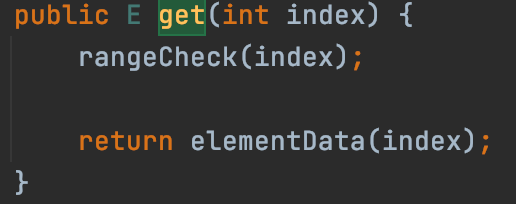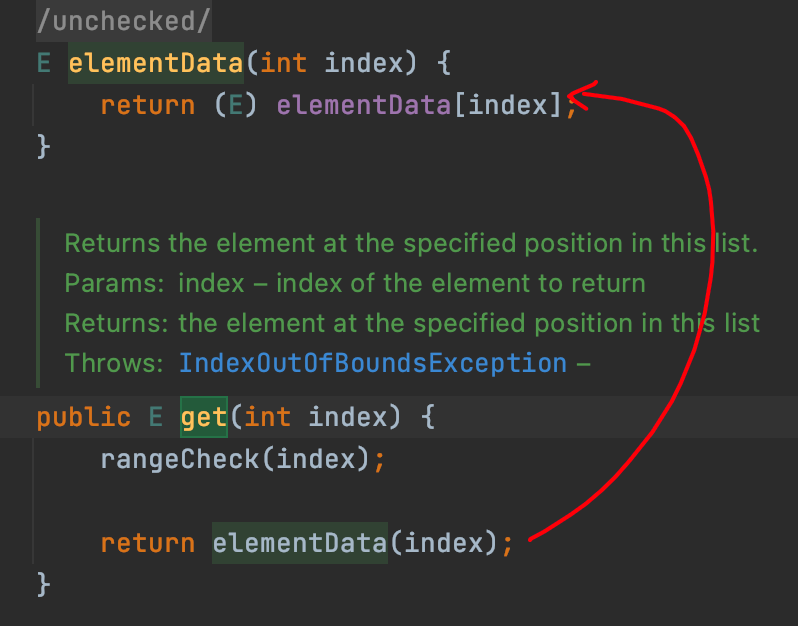Java基础1-String/List/TreeSet/TreeMap
文章目录
Stringbuffer和Stringbuilder的区别?
- Stringbuffer是线程安全的(加了synchronized关键字),Stringbuilder是不安全的,方法基本一致
- Stringbuffer中有个toStringCache字段,字段上的解释是返回最后一次toString的缓存值,一旦StringBuffer被修改就清除这个缓存值。如:
-

- 在这里会用到toStringCache,如果没改过(!=null),就不用复制了,于是会加快一些运行速度,但是呢,由于synchronized锁的存在,总体速度我认为还是Stringbuilder比较高。
-

-
ArrayList和LinkedList以及vector区别?
-
这个问题应该从三者的底层数据结构来看:
-
LinkedList底层是链表,因此考虑链表的优缺点即可——随机比较慢(get方法是有的),但是插入删除快
- 从构造函数可以知道,这玩意是个双向链表,且有俩指针:first last
-
- get的实现:
- 首先check保证index合法性,相当于越界检查,然后调用node方法,返回元素的item属性——相当于value
-
- 而从node方法中可以知道,get方法的实现平均时间复杂度为n/4,因为它将遍历分成两种模式,向前/向后,于是最长不超过长度的一半(size>>1是移位,相当于处以2,但是更快)
-

- 首先check保证index合法性,相当于越界检查,然后调用node方法,返回元素的item属性——相当于value
- 从构造函数可以知道,这玩意是个双向链表,且有俩指针:first last
-
ArrayList底层是数组,因此考虑数组的优缺点即可——随机查找快,但是插入删除(尤其是前部的)慢
- 从源码可以知道,他的get是直接返回下标就行了
-
- 但是呢add方法就有意思了,从下面源码可以看到,它调用了系统的arraycopy,于是就慢了
-
- 还有一点就是ArrayList的iterator迭代器在多线程的状态下可能会发生数据混乱。
- 从源码可以知道,他的get是直接返回下标就行了
-
vector的底层也是数组,对比ArrayList可以发现是非常类似的,因此在大多数情况下我们可以吧ArrayList当成强化版的vector:
-

-

-
但是呢,我们从下面的源码可以观察到(get方法),vector在get方法上都上了锁。。。。于是可想而知在多线程情况下的效率低下,但是他是线程安全的,而ArrayList则没有synchronized,也没见到其他保证线程安全的机制,于是可以认为它是不安全的。
-
//ArrayList public E get(int index) { rangeCheck(index); return elementData(index); } //vector public synchronized E get(int index) { if (index >= elementCount) throw new ArrayIndexOutOfBoundsException(index); return elementData(index); }
-
-
再有呢,就是扩容规则上的区别,ArrayList每次扩容1.5倍(大约,因为移位的关系),而vector每次加一个capacityIncrement (这个值在初始化的时候可以设置的)
-
//ArrayList private void grow(int minCapacity) { // overflow-conscious code int oldCapacity = elementData.length; int newCapacity = oldCapacity + (oldCapacity >> 1); if (newCapacity - minCapacity < 0) newCapacity = minCapacity; if (newCapacity - MAX_ARRAY_SIZE > 0) newCapacity = hugeCapacity(minCapacity); // minCapacity is usually close to size, so this is a win: elementData = Arrays.copyOf(elementData, newCapacity); } //vector private void grow(int minCapacity) { //而且俺发现,这个minCapacity在自动扩容的时候是一个一个扩容的。。。。这个效率低得离谱 // overflow-conscious code int oldCapacity = elementData.length; int newCapacity = oldCapacity + ((capacityIncrement > 0) ? capacityIncrement : oldCapacity); if (newCapacity - minCapacity < 0) newCapacity = minCapacity; if (newCapacity - MAX_ARRAY_SIZE > 0) newCapacity = hugeCapacity(minCapacity); elementData = Arrays.copyOf(elementData, newCapacity); } //add算法扩容的时候参数是elementCount+1。。。。。就扩容了一个 private void ensureCapacityHelper(int minCapacity) { // overflow-conscious code if (minCapacity - elementData.length > 0) grow(minCapacity); } public synchronized boolean add(E e) { modCount++; ensureCapacityHelper(elementCount + 1); elementData[elementCount++] = e; return true; }
-
-
-
有关于TreeSet
-
他是基于NavigableMap实现,而在构造中传的是TreeMap,代码摘出如下:
-
private transient NavigableMap<E,Object> m; TreeSet(NavigableMap<E,Object> m) { this.m = m; } public TreeSet() { this(new TreeMap<E,Object>()); } -
我们翻一翻TreeMap的源码,可以看到TreeMap是implement了NavigableMap
-
-
于是我们看TreeSet的源码可以发现,基本都是调用NavigableMap(或者可以说TreeMap)的方法,只不过它用不到TreeMap的value(直接用的PRESENT填充了),随便找一点:
-
-
然后看看TreeMap的实现
有关于TreeMap
private transient Entry<K,V> root;
// Red-black mechanics
private static final boolean RED = false;
private static final boolean BLACK = true;
//这是基于红黑树的实现的entry,可以预见一定还有一个改变color的方法
static final class Entry<K,V> implements Map.Entry<K,V> {
K key;
V value;
Entry<K,V> left;
Entry<K,V> right;
Entry<K,V> parent;
boolean color = BLACK;
/**
* Make a new cell with given key, value, and parent, and with
* {@code null} child links, and BLACK color.
*/
Entry(K key, V value, Entry<K,V> parent) {
this.key = key;
this.value = value;
this.parent = parent;
}
//其他还有些getset以及equal和tostring就省略了
}
-
get方法
-
public V get(Object key) { //只是调用getEntry,然后做了一个判空 Entry<K,V> p = getEntry(key); return (p==null ? null : p.value); } //getEntry就是走红黑树 final Entry<K,V> getEntry(Object key) { // Offload comparator-based version for sake of performance if (comparator != null) return getEntryUsingComparator(key); if (key == null) throw new NullPointerException(); @SuppressWarnings("unchecked") Comparable<? super K> k = (Comparable<? super K>) key; Entry<K,V> p = root; while (p != null) { int cmp = k.compareTo(p.key); if (cmp < 0) p = p.left; else if (cmp > 0) p = p.right; else return p; } return null; } -
Put方法
-
public V put(K key, V value) { Entry<K,V> t = root; //若树为空,则点作为root节点 if (t == null) { compare(key, key); // type (and possibly null) check root = new Entry<>(key, value, null); size = 1; modCount++; return null; } int cmp; Entry<K,V> parent; // split comparator and comparable paths // 比较器 Comparator<? super K> cpr = comparator; // 走树,找到空节点的parent if (cpr != null) { do { parent = t; cmp = cpr.compare(key, t.key); if (cmp < 0) t = t.left; else if (cmp > 0) t = t.right; else return t.setValue(value); } while (t != null); } else { if (key == null) throw new NullPointerException(); @SuppressWarnings("unchecked") Comparable<? super K> k = (Comparable<? super K>) key; do { parent = t; cmp = k.compareTo(t.key); if (cmp < 0) t = t.left; else if (cmp > 0) t = t.right; else return t.setValue(value); } while (t != null); } //插入节点 Entry<K,V> e = new Entry<>(key, value, parent); if (cmp < 0) parent.left = e; else parent.right = e; fixAfterInsertion(e); size++; modCount++; return null; } //调整插入后的红黑树 private void fixAfterInsertion(Entry<K,V> x) { x.color = RED; while (x != null && x != root && x.parent.color == RED) { if (parentOf(x) == leftOf(parentOf(parentOf(x)))) { Entry<K,V> y = rightOf(parentOf(parentOf(x))); if (colorOf(y) == RED) { setColor(parentOf(x), BLACK); setColor(y, BLACK); setColor(parentOf(parentOf(x)), RED); x = parentOf(parentOf(x)); } else { if (x == rightOf(parentOf(x))) { x = parentOf(x); rotateLeft(x); } setColor(parentOf(x), BLACK); setColor(parentOf(parentOf(x)), RED); rotateRight(parentOf(parentOf(x))); } } else { Entry<K,V> y = leftOf(parentOf(parentOf(x))); if (colorOf(y) == RED) { setColor(parentOf(x), BLACK); setColor(y, BLACK); setColor(parentOf(parentOf(x)), RED); x = parentOf(parentOf(x)); } else { if (x == leftOf(parentOf(x))) { x = parentOf(x); rotateRight(x); } setColor(parentOf(x), BLACK); setColor(parentOf(parentOf(x)), RED); rotateLeft(parentOf(parentOf(x))); } } } root.color = BLACK; }
有关于红黑树

- 要求:
- 根节点是黑色的
- 叶节点为不存储数据的黑色空节点
- 任何相邻的两个节点不能同时为红色
- 任意节点到其可到达的叶节点间包含相同数量的黑色节点
- 非严格的平衡二叉树,于是每次插入的时候有时候并不需要复杂的旋转平衡操作,代价是查找效率微微降低(数量级不变)





